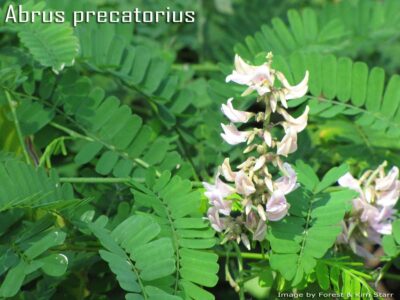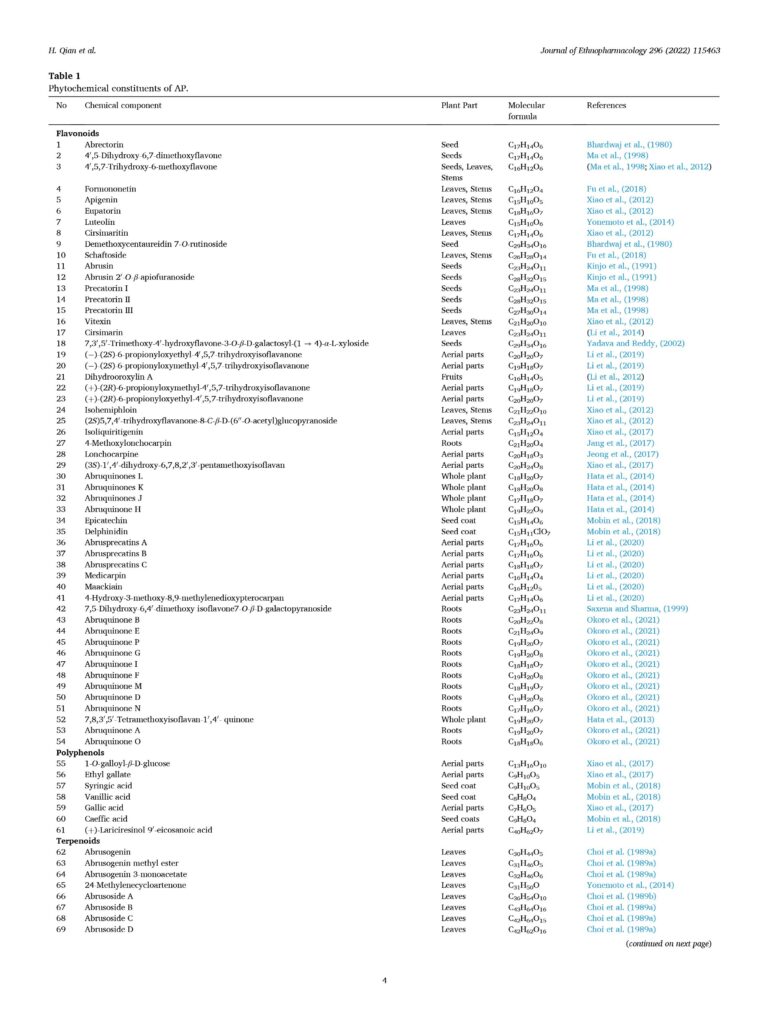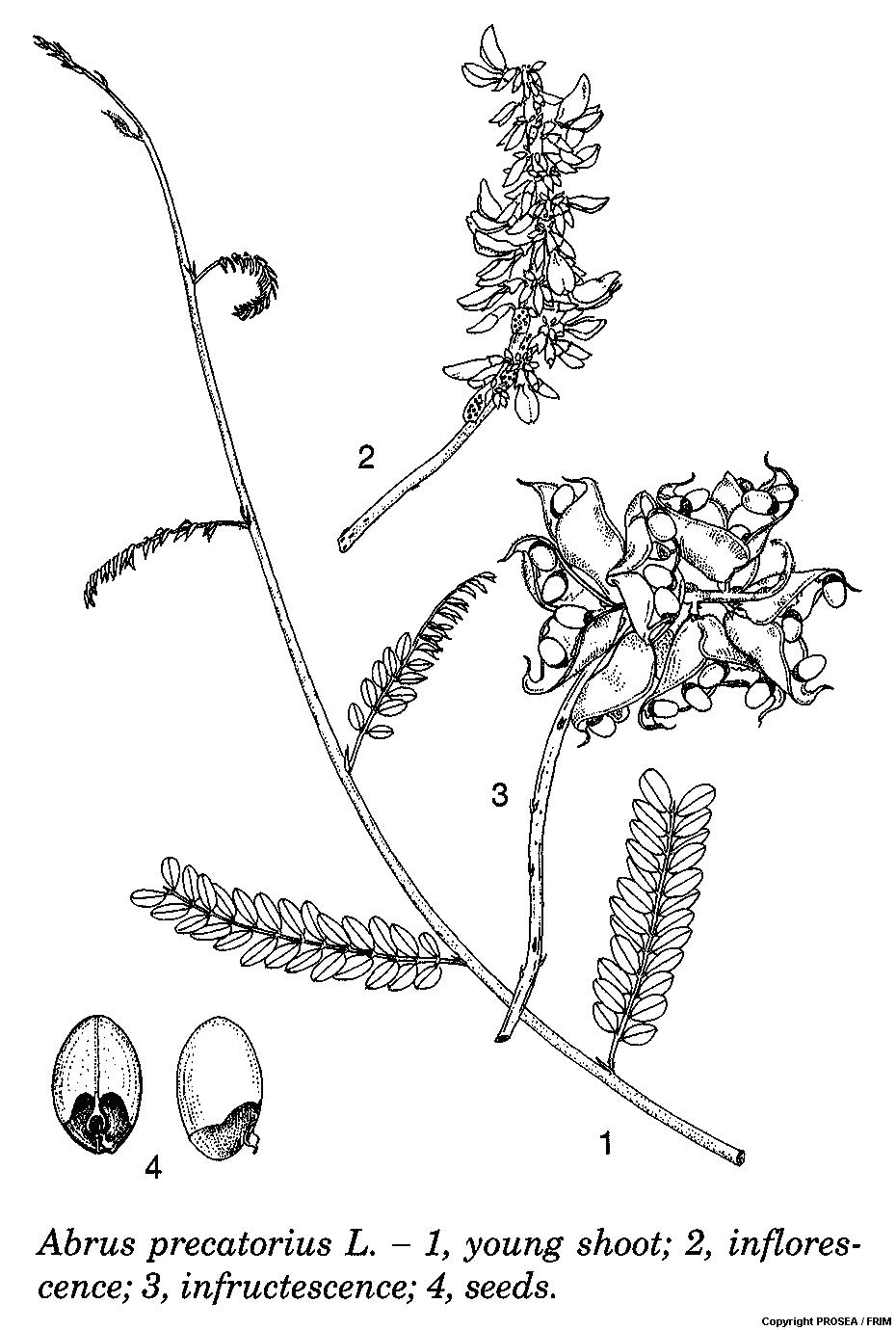Scientific Name
Abrus precatorius L.
Synonyms
Abrus abrus (L.) Wright, Abrus cyaneus R.Vig., Abrus maculatus Noronha, Abrus minor Desv., Abrus pauciflorus Desv., Abrus squamulosus E.Mey., Abrus tunguensis Lima, Glycine abrus L. [1]
Vernacular Name
| Malaysia | Akar saga [2] |
| English | Indian liquorice, jequirity bean, crab’s eye, rosary pea [2] |
| India | Gunja (Sanskrit), Ratti (Hindi), Mulati (Punjabi), Atti (Tamil), Gurija (Telugu), Kunni (Malayalam), Chanauthi (Gujrati), Kunch (Bengali), Ghunchi (Urdu), Chasmekhrosh (Pharsi) [3] |
| Indonesia | Saga, saga manis (General); saga telik (Javanese) [2] |
| Philippines | Saga, kansasaga, bangati (General) [2] |
| Myanmar | Ywe-nge [2] |
| Vietnam | D[aa]y c[uw][owf]m th[ar]o, cam th[ar]o d[aa]y, d[aa]y t[uw][ow]ng t[uw] [2] |
| Thailand | Ma klam taanuu (Bangkok); klam khruea (Chiang Mai); ma khaam thao (Trang) [2] |
| Cambodia | ângkreem, kre:m krâ:m (Kompong Thom) [2] |
| Laos | Khua sa em, makam [2] |
| France | Jéquirity, liane reglisse [2] |
Plant Taxanomy
| Kingdom | Plantae |
|---|---|
| Division | Magnoliophyta |
| Order | Fabales |
| Family | Fabaceae |
| Subfamily | Faboideae |
| Tribe | Abreae |
| Genus | Abrus |
| Species | Abrus precatorius |
Geographical Distributions
A. precatorius is native to India [3] and found in Africa, tropical and subtropical America (introduced), tropical Asia, Australia and the Pacific Islands; throughout Southeast Asia. It growsin grasslands, in cropped lands, thickets, edges of monsoon rain forests and gallery forests up to 1500 m altitude [2].
Botanical Description
A. precatorius is a woody climber from Fabaceae family which can reach up to 6(-9) m long [2].
The stems often attain 1.5 cm in diametre [2].
There are 16-34 leaves which are oblong, with obovate-oblong or ovate leaflets and the apex is obtuse to acuminate [2].
The inflorescence is thick, robust and usually curved [2].
The flowers are on cushion-like nodes with dense clusters [2].

The fruit is oblong and inflated with 1-7 seeds [2].
The seeds are ovoid, scarlet with area around the black hilum, rarely entire black and whitish or yellowish [2].
Cultivation
No documentation
Chemical Constituent
More than 166 chemical compounds have been identified from A.prectaorius, which primarily cover flavonoids, phenolics, terpenoids, steroids, alkaloids, organic acids, esters, proteins, polysaccharides, and so on.

The comprehensive list of chemical constituent could be find at Reference number 6. [6]
Plant Part Used
No documentation
Traditional Use
No documentation
Preclinical Data
Anti-Diabetic effect
A preclinical study as a response to verify the use of Abrus precatorius leaves by local communities in the western region of Ghana as an antidiabetic herbal medicine. Specifically, the study investigated glucose lowering and pancreato-protective effects of Abrus precatorius leaf extract in STZ/nicotinamide (NIC)-induced diabetic rat model. Cumulatively, the Abrus precatorius leaf extract (100, 200 and 400 mg/kg respectively) dose-dependently decreased the initial Fasting Blood Glucose (FBG) by 55.22, 76.15 and 77.77% respectively compared to the control group (−1.04%) and metformin (72.29%) groups. Abrus precatorius leaf extract treatment group recovered damaged pancreatic β-cells and also increased median cross-sectional area (x106 μm2) of pancreatic islets compared to that of model group. Abrus precatorius leaf extract treatment group significantly (P < 0.05) increased total anti-oxidant capacity (5.21 ± 0.02 AscAE μg/mL) of plasma, kidney and liver compared to model (4.06 ± 0.04 AscAE μg/mL) and metformin (4.87 ± 0.03 AscAE μg/mL) groups[7]
Precaution : Anti-fertility activity
A preclinical trial to study the antifertility activity of A.prectaorius seed extract intraperitoneally administered on sperm production and DNA integrity of spermatozoa in adult male albino mice of BALB/c strain. The daily sperm production was measured by counting testicular spermatids in Horwell chamber while DNA damage in epididymal spermatozoa was determined by comet assay. The study finds A. precatorius seed extract has fragmentation effects on DNA of spermatozoa in adult male mice with significant increase (p< 0.001) compared to control. Both ethanoic and ethanolic (20 and 60 mg/kg) seed extract of A. precatorius induced a highly significant (p < 0.001) decrease in mean testicular sperm count and daily sperm production compared to control. The reversibility in sperm production was observed in all the treated animals after 20 days of withdrawal of treatment.[4].
A preclinical trial to study the antifertility activity of A.prectaorius seed extract, orally administered on female rats for 30 days. This comparative study examines the antifertility activity using different organic fractions of acetone extract (n-Hexane solubles, Ethyl acetate (EtOAc) solubles ,Methanol (MeOH) solubles, and crude powder of A. precatorius seeds to study the impact on the hormonal profiles (LH, FSH and Estrogen hormones) and histology of main reproductive organs with standard contraceptive drug (Nordette® 28) as positive control group. The results exhibit 100% antifertility activity of Abrus precatorius seeds with n-Hexane solubles (2mg/rat/day), EtOAc solubles (4mg/rat/day), MeOH solubles (6mg/rat/day) and crude seed powder (100mg/rat/day) with lowest levels of serum luteinizing hormone (LH), follicle stimulating hormone (FSH)and 17β-estradiol. Histologically, the treatment with those mentioned concentrations above, reduce the numbers of developing follicles, reduced endometrial height, fewer uterine glands with shrunken morphology, poor vascularity, and stroma compactness for fetal implantation [5].
Clinical Data
No documentation
Poisonous Management
No documentation.
Line Drawing

References
-
The Plant List. Ver1.1. Abrus precatorius L. [updated 2010 July 14; cited 2014 July 8]. c2013. Available from: http://www.theplantlist.org/tpl1.1/record/ild-2477
- Kumar P, Kumar N. AYURVEDIC ASPECTS OF GUNJA (ABRUS PRECATORIUS) WSR AGADATANTRA.
- Jahan S, Rasool S, Khan MA, Ahmad M, Zafar M, Arsahd M, Abbasi AM. Antifertility effects of ethanolic seed extract of Abrus precatorius L. on sperm production and DNA integrity in adult male mice. J Med Plants Res. 2009 Oct 1;3(10):809-14
- Hannan MA, Hossain MA, Islam MT. Seed extracts of a Bangladeshi medicinal plant Abrus precatorius L. show antifertility activity in female rats. Advances in Traditional Medicine. 2010;10(2):103-10
- Qian H, Wang L, Li Y, Wang B, Li C, Fang L, Tang L. The traditional uses, phytochemistry and pharmacology of Abrus precatorius L.: A comprehensive review. Journal of Ethnopharmacology. 2022 Oct 5;296:115463.
- Boye A, Acheampong DO, Gyamerah EO, Asiamah EA, Addo JK, Mensah DA, Brah AS, Ayiku PJ. Glucose lowering and pancreato-protective effects of Abrus precatorius (L.) leaf extract in normoglycemic and STZ/Nicotinamide–Induced diabetic rats. Journal of ethnopharmacology. 2020 Aug 10;258:112918.
Last update on : 2 August 2022


